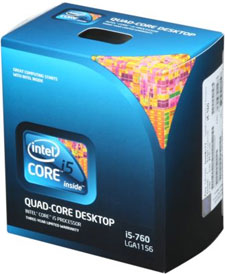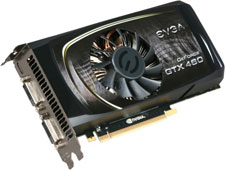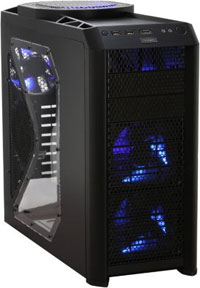Holiday 2010 System Builder's Guide
by AnandTech Staff, edited by Jarred Walton on November 19, 2010 2:00 AM EST- Posted in
- Guides
- Systems
- Holiday 2010
| Vivek's Midrange Intel System | ||
| Hardware | Component | Price |
| Processor |
Intel Core i5-760 Lynnfield 45nm (4x2.8GHz to 3.33GHz Turbo, 8MB L3, 95W) |
$200 |
| Motherboard | Gigabyte GA-P55-USB3 (Intel P55) | $120 |
| Video | EVGA GTX 460 768MB (768-P3-1360-TR) ($30 MIR) | $140 |
| Alternate GPU | ASUS GTX 460 768MB (ENGTX460 TOP)($20 MIR) | ($150) |
| Alternate GPU | ASUS Radeon HD 6850 1GB (EAH6850) | ($200) |
| Memory |
Corsair XMS3 2x2GB DDR3-1600 CL9 (CMX4GX3M2A1600C9) |
$65 |
| Hard Drive | WD Caviar Blue 1TB (WD10EALS) | $70 |
| Optical Drive | ASUS 24x DVDRW (DRW-24B1ST) | $20 |
| Power Supply | OCZ ModXStream Pro 700W (OCZ700MXSP) ($25 MIR) | $55 |
| Case | Antec Nine Hundred Two | $89 |
| Total System Price (Price based on GPU choice) | $759-$819 | |
When Jarred pitched his idea of a midrange gamer build, I liked the general idea except for one thing—the AMD processor. I'm more of an Intel guy at heart, so I tried to envision a similar midrange system built around an Intel platform. I built a very parallel system for personal use around this time last year, so I'll toss in a few anecdotes from my experience.

The processor was by far the easiest choice to make. At the price point we're looking at, the Core i5-760 makes the most sense. It's a quad-core Lynnfield running at 2.8GHz, with the only difference between it and the $280, 2.93GHz i7-860 being the clock speed bump and the lack of Hyper-Threading in the i5. Given that you've got four cores to work with, you won't miss the extra threading capabilities unless you're running some really highly threaded workloads. The 2.66GHz i5-750 is still kicking around at $199 (I can't believe that Intel has kept it at exactly the same price it was a year ago when I bought one!), but you can find the 760 for the same price. I figure it's not worth the $80 bump to the i7 line, as that money is better spent elsewhere.
For the motherboard, I went with the Gigabyte GA-P55-USB3. It's a rock solid board with USB 3.0 and a second PCI-E slot for CrossFireX support. In a mid-priced motherboard, there's not too much else you can ask for (except for maybe IEEE 1394). The Gigabyte P55 line has been popular since the launch of Lynnfield, and based on my experience I have no problems recommending it. As with Jarred's build, if you're serious about CrossFire you'll probably want to go with a different board that can do x8/x8 to the GPUs; as luck would have it, Biostar's T5 XE CFX-SLI has dual x8 slots and tosses in SLI support (via a PLX chip), and depending on the vendor it's even cheaper than the Gigabyte offering. Is it as reliable and does it have great support should something go wrong? We haven't had any serious issues with Biostar, but they can be a bit hit-or-miss.
RAM is kind of dependant on how much you need—I went with 4GB in my build last year and haven't felt short of memory, but I'm adding more this Black Friday just in case. For this build, I went with a Corsair XMS3 4GB (2x2GB) kit of DDR3-1600. Corsair's XMS3 was one of the more reasonably priced RAM kits on Newegg, but you can really go for whatever you feel comfortable with. I know a lot of people who like the G-Skill Ripjaws line, but they're rather pricey especially if you go for the 7-8-7-24 timings ($88 versus $75 for the 9-9-9-24 Ripjaws, and $65 for the XMS3s that also run at 9-9-9-24). Unless you have a specific preference for brand, you're probably better off going for whoever has the best sale.
Hard drives are another place where once you determine the capacity and speed, you're not going to get a whole lot of performance variation between different brands. I know people that swear by Seagate, I know some that swear by Western Digital, I know a lot that swear they hate either (or both), and there's Anand, who swears against hard drives on principle. In all honesty, I don't care either way, so I specced this system with the WD Caviar Blue 1TB 7200RPM drive, which at $69 is not a bad buy. There are 1TB drives from Seagate, Samsung, and Hitachi at the same price, so you're not at a loss for choice.

The graphics card is where things get interesting. If you're a serious gamer, I figure the lowest you want to go is the NVIDIA GTX 460 768MB. Most of those are going for $169, but the bog-standard EVGA GTX 460 listed above has a $30 rebate on top of that, and the more customized (and mildly factory-overclocked) ASUS ENGTX 460 comes with a $20 MIR. So if you don't mind the MIR, you can get away with a "low-end" GTX 460 for $140-150. Given the overclocking potential inherent to the GTX 460, that's a pretty good price.
But what if you want something faster? The best place to look is the HD 6850 (the 6870, at $240-300, is a bit too expensive for a midrange build). Ryan really liked the ASUS EAH6850 when he looked at the XFX, MSI, and ASUS retail HD 6850 cards earlier this month, and so it makes another appearance here. At $200, it's competitively priced against the rest of the HD 6850 partner cards, and it makes a good tradeoff between temperatures and noise. Like the ASUS ENGTX 460, it comes with a token overclock and ASUS' highly effective Direct CU cooler. It's faster than the comparably priced 1GB GTX 460 cards, so it's a worthwhile upgrade to make if you'll make use of the extra graphics horsepower on hand.
Of course, now you have to decide if you're at all interested in adding a second GPU in the future; if so, you should note that most budget P55 boards only support CrossFireX. For those going the AMD route, the specced Gigabyte board will be fine, but if you're after SLI support, the Biostar T5 XE CFX-SLI has what you need for $15 more than the GA-P55, with an epic, highlighter-esque colour scheme thrown in just for kicks.
For the power supply, I went with the OCZ ModXStream 700W. This is what I ended up buying for my build last year, and I’ve had no problems with it. There's usually a good sale on it somewhere; I picked it up for $49 last year (after a $35 rebate) and it’s currently going for $55 after a $25 rebate. I know that the Corsair line of PSUs is very popular, but they’re significantly pricier than the OCZ, as are the Antec PSUs (unless you get a combo deal on one with a case like in Jarred’s build). Generally speaking, most of the 80 Plus certified PSUs will work well; some are still better than others, but the difference between 82% and 87% efficiency isn't all that great and the price often climbs rapidly once you move beyond the Bronze level. The OCZ is a standard 80 Plus model at a good price, but if you're looking for other options the Seasonic S12II 520W is Bronze certified, well reviewed, and costs just $10 more than the OCZ.

Case choices are very personal; I prefer flowing and elegant cases, like the old Cooler Master WaveMaster and the Thermaltake Tsunami, which is what I got for my own system. I abhor the design of the wildly popular Antec Nine Hundred—something about the weirdly pentagonal side just doesn’t sit right with me, though I must admit that it is a very high quality case. The Nine Hundred Two on the other hand has a more rectangular design that suits my taste much better, but at $90 it’s not the cheapest case on the block. Jarred specced his build with the Antec Three Hundred, which is a bit smaller and a bit cheaper, but get what you like.
So how does this stack up against Jarred's build? It has a more expensive case, PSU, motherboard, and processor with a slightly slower GPU (assuming you get the standard GTX 460 768MB), but then the i5-760 will generally outperform Phenom II 965. As configured and with the mail-in rebate for the GTX 460 and PSU, the net difference is only around $30, but if we just look at the motherboard and processor the "Intel tax" is about $50 (or about 7% looking at the entire system). Whichever GPU and system you choose, both of our midrange builds will handle just about any task you might throw their way—including gaming.










112 Comments
View All Comments
JarredWalton - Friday, November 19, 2010 - link
Honestly, the AMD/Intel stuff was in a large part based on editor personal preference. For a budget build, it's hard to match AMD, but ultimately it's just a $40 upgrade to Intel. Some of us really like AMD, some of us really prefer to run Intel. Funny thing is that I'm more of an Intel guy but decided that AMD made the most sense for what I was building, and Vivek definitely wanted to do Intel. Also consider that we didn't want a ton of overlap; if you asked each of us for a system we would REALLY build, no one would put together a dream setup, and likewise few of us would go budget; you'd get all sorts of $700-$1300 builds.The graphics card side was left entirely up to the editors. Some felt the need to list both options and others went with what they felt was "best". But then, there's enough parity in current GPUs that you really can go either way and be fine. So that's pretty much how the process went.
wumpus - Friday, November 19, 2010 - link
Why in the world do you need to make separate Intel/AMD builds to keep the fanboys happy, and why don't you bother to include AMD/Nvidia splits as well?Second, I have to question pairing a GTX580 with a 1920x1200 monitor. While it does let you play crysis2 with absolutely everything turned on, it will be spinning its wheels doing everything else. While trying to build a decent $900 eyefinity* system might require raiding the budget from other components, the end result (5' of monitor instead of a big port hole) is likely superior to any single monitor 1920x1200 (even 24" IPS and a GPU that *never* drops below 60fps).
Finally, with all the worrying over hard drive brands nobody gave a thought to RAID5? You would think in the "ultimate HTPC" system might want to keep data after a drive death, but I guess all that expensive and noisy gear already thrown at it priced [physical] data integrity out the window (an SSD in an HTPC? Junk the software first and put something that works in its place!)
*note that a pair of 460s should not be ignored, and probably fit the price best when trying to match with 3 monitors
JarredWalton - Friday, November 19, 2010 - link
Might want to read Brian's build a bit more carefully:"On every system I've built in recent memory, I've gone with an SSD + RAID array of slow but capacious storage; I think the same is best here. Get four or five 1.5TB or higher HDDs of whatever brand makes you feel warmest inside, toss them in a RAID5 set, and enjoy a crap-ton of storage that's fully redundant. I suppose if you're really feeling ultimate, you could get a RAID card instead of using the ICH10R's software fakeRAID, but it probably isn't critical unless you want to eek out everything you can from those mechanical drives."
Anand has also added his build, with RAID1.
As for 580 + WUXGA, while Crysis is the game everyone mentions, let me just state that Bad Company 2 (and the new Medal of Honor uses the same engine) can be very demanding as well... about as demanding as Crysis in fact. Mafia 2, Metro 2033, and a variety of upcoming and recent titles are also very demanding. I've got a 30" panel with 5850 CrossFire, and I certainly can't max out everything!
ajlueke - Friday, November 19, 2010 - link
I did think about doing RAID 5 in my build. But in all honesty, out of the 3 WD20EARS drives I have purchased and the several 1 TB black editions from WD ,I have never had a single one fail...ever. Certainly I back up my programs and documents as well as anything that cannot be replaced such as pictures and itunes purchases. All the other data on the media drives is already backed up on the physcial discs from which they were ripped, and are now safely stored in my basement. Yes, it would be time consuming to rerip all of the media on a failed drive, but it is also time consuming to rebuild a RAID 5 array. I found the money spent on an extra drive for the storage overhead of a RAID 5 is better spent on cooling solutions to prevent drive failure in the first place. As I have never had a HDD fail in five years of building HTPC systems, I think the policy has worked out fairly well for me. The setup is actually extremely quiet, but certainly not as much some smaller solutions. But adding an SSD definately helps with the noise, as do the green edition WD drives.Jovec - Saturday, November 20, 2010 - link
I agree with the need for data backup, but RAID 1/5 really has no place in 99% of home usage situations. You are better off using a spare drive(s) for a proper backup. RAID provides insurance against hardware failures, but not user error. You are much more likely to suffer an accidental deletion/overwrite/etc than a drive failure.mattgmann - Friday, November 19, 2010 - link
Everything has looked pretty good until this machine.For one, why is a monitor now included? Though I do think it's a good monitor (nice alternative to the dell U2410). But, as a gaming system, why not get 3 24" tn panels for the same price for eyefinity goodness?
Also, what is with the use of all the WD drives? They're good drives, but the samsung f3 and f4 drives are just plain faster and don't cost any more.
Is a sound card really necessary? I would only include it if you're including speakers.
Iketh - Saturday, November 20, 2010 - link
i really appreciated the addition of a monitor in the higher priced builds... the cheaper builds are assumed you'll reuse your current display, just common sense in my book... and then eyefinity? no thanks, unless a monitor with one large curved display exists...i have never and will never build my mid-range or higher gaming PC without a dedicated sound card... the sound clarity is very noticeable for headphones or higher-end speaker systems... but I agree 100% with not a mention of speakers for the systems including a dedicated sound card, please add suggestions!!
Ryan Smith - Tuesday, November 23, 2010 - link
3 TN monitors is certainly an option and I mentioned it in the writeup. However all of these builds are ultimately based at least partially around our preferences, and my preference is for a larger, high quality monitor paired with a single fast GPU, as opposed to many low quality monitors and a dual-GPU configuration.Nataku - Friday, November 19, 2010 - link
Eh... I just thought we'd see a few low~mid range systems with SSDs lolI was going to put together a system like below (im going to wait for sandy bridge instead though)
Zotac H55 w/ wifi
One of the lower cost SSD
probably thermaltake's Element Q for case
cheapest 4GB kit I can find
guess size of HDD does still matter more XD
Nataku - Friday, November 19, 2010 - link
and... stupid of me to forget to include the CPU =.= i was thinking i3 lower end ones